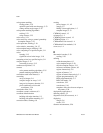Glossary
© National Instruments Corporation G-13 IMAQ Vision for Visual Basic User Manual
optical representation Contains the low-frequency information at the center and the high-
frequency information at the corners of an FFT-transformed image.
outer gradient Finds the outer boundary of objects.
P
palette The gradation of colors used to display an image on screen, usually defined
by a CLUT.
particle A connected region or grouping of non-zero pixels in a binary image.
particle analysis A series of processing operations and analysis functions that produce some
information about the particles in an image.
pattern matching The technique used to locate quickly a grayscale template within a
grayscale image
picture element An element of a digital image. Also called pixel.
pixel Picture element. The smallest division that makes up the video scan line.
For display on a computer monitor, a pixel's optimum dimension is square
(aspect ratio of 1:1, or the width equal to the height).
pixel aspect ratio The ratio between the physical horizontal size and the vertical size of the
region covered by the pixel. An acquired pixel should optimally be square,
thus the optimal value is 1.0, but typically it falls between 0.95 and 1.05,
depending on camera quality.
pixel calibration Directly calibrates the physical dimensions of a pixel in an image.
pixel depth The number of bits used to represent the gray level of a pixel.
PNG Portable Network Graphic. An image file format for storing 8-bit, 16-bit,
and color images with lossless compression. PNG images have the file
extension PNG.
Prewitt filter An edge detection algorithm that extracts the contours in gray-level values
using a 3 × 3 filter kernel.


















